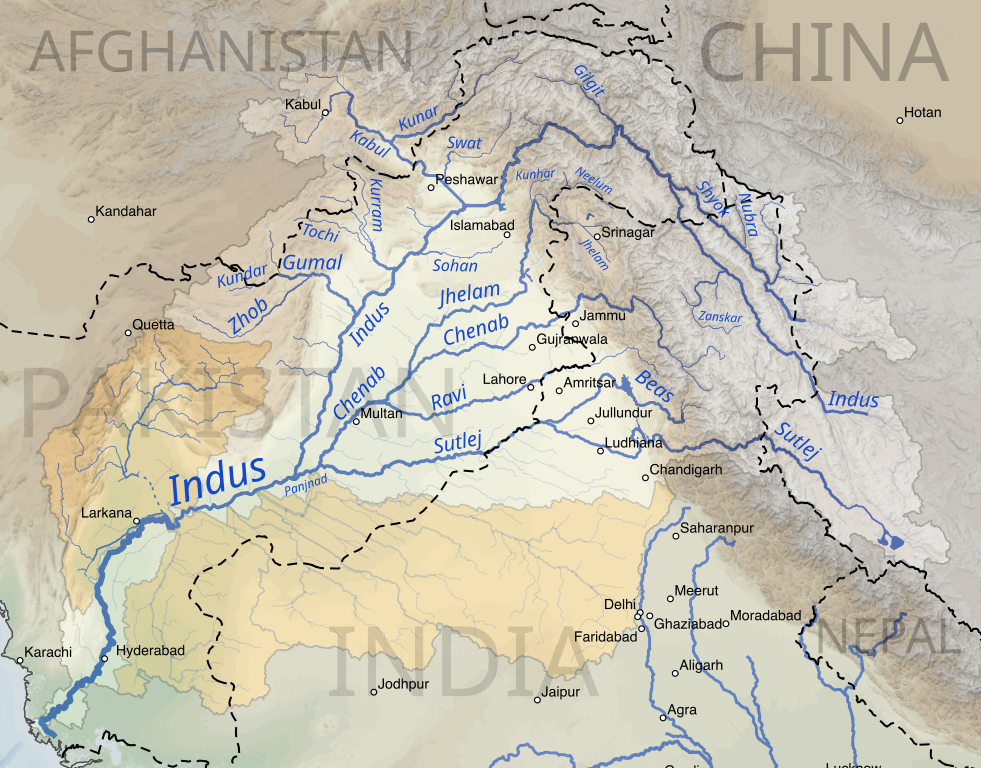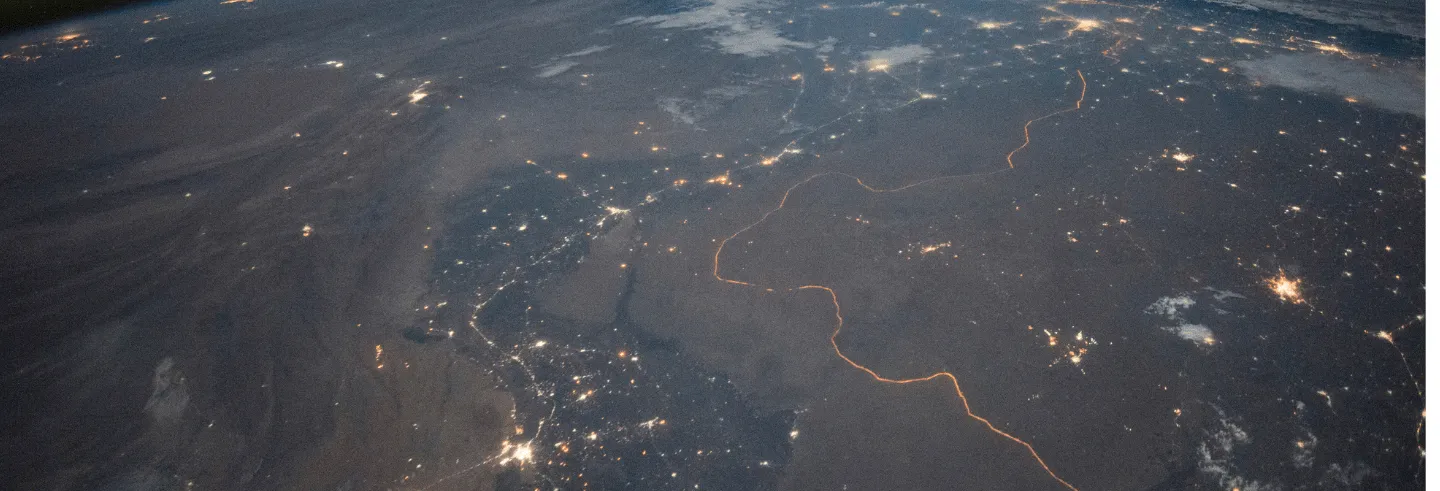Amidst the series of diplomatic measures initiated by the Indian government against Pakistan in response to the Pahalgam terrorist attack of 22 April 2025, the decision to keep the Indus Waters Treaty "in abeyance" is perhaps the most potent.
The Indus river system is a lifeline for Pakistan. Nine out of 10 Pakistanis live within the Indus basin. It is the primary source for freshwater and hydropower generation and irrigates over 80% of cultivated land. The Indus is also a source of domestic conflict: in recent times, growing water scarcity in the largely arid regions of Sindh and Punjab has deepened internal fissures in the Pakistani political establishment. It is therefore unsurprising that Pakistan labelled India’s decision an “act of war” and threatened legal action.
The suspension of the treaty may not have any immediate practical consequences. India’s upstream infrastructure to use, store and divert water from the western rivers is limited, and fresh infrastructure (aside from its ecological impacts) will likely take a decade to build. Yet, the suspension is a significant policy change – water-sharing arrangements are no longer ringfenced away from cross-border military and political turbulence. It marks the beginning of the end of the Indus Treaty, which miraculously survived four wars, decades of cross-border terrorism, and a growing distrust between the two nations.
Giveaways for peace
Pahalgam was the immediate cause for New Delhi's decision, but Indian complaints over the Indus Treaty are not new. Disagreements over water sharing in the Indus Basin go back to the early 20th century, with the colonial Indian government arbitrating claims between provinces (Punjab and Sindh) and princely states (Bhawalpur and Bikaner).
With Partition, India and Pakistan inherited what now became inter-national disputes. Cyril Radcliffe’s infamous Punjab Boundary Commission of 1947 made a stillborn attempt to resolve the water problem as part of the territorial dispute. Jawaharlal Nehru and Mohammad Ali Jinnah both told Radcliffe to stop “playing politics.” Jinnah was characteristically intransigent (claiming he would rather Pakistan have “deserts than fertile fields watered by courtesy of Hindus”) and Nehru was uncharacteristically unfriendly, making clear that “what India did with India’s rivers was India’s affair” (Biswas 1992: 203).
One of India’s motives in 1948 – reflected equally in 2025 – was to put pressure on Pakistan to withdraw armed ‘volunteers’ from Kashmir.
In a last-ditch effort, the Chief Engineers of East and West Punjab came to a temporary Standstill Agreement to maintain the pre-Partition allocation. As the agreement expired in March 1948, no resolution was reached, and India discontinued water flows to the Upper Bari Doab Canal. Aloys Michel’s The Indus Rivers: A Study of the Effects of Partition argues that one of India’s motives in 1948 – reflected equally in 2025 – was to put pressure on Pakistan to withdraw armed ‘volunteers’ from Kashmir.
Water flows were restarted subsequently, with Nehru and Pakistani Prime Minister Liaquat Ali Khan signing a second temporary arrangement, the Delhi Agreement. The agreement soon came under pressure. Khan claimed the agreement was signed “under duress” and demanded, consistent with Pakistan’s present policy, to internationalize the dispute with a third-party adjudication at the International Court of Justice (ICJ), while Nehru suggested a bilateral commission. This unhappy modus vivendi persisted till the World Bank-mediated 1960 Indus Waters Treaty.

The treaty was the result of eight years of negotiations. Pakistan’s opening stance suggested 102.5 million acre-feet (maf) of water for itself (86%) and 15.5 maf for India (13%). India suggested 90 maf (76%) for Pakistan and 29 maf (24%) for itself. The World Bank’s proposal broadly averaged these out, suggesting the western rivers for Pakistan and the eastern rivers for India. Despite the skewed water flows, India accepted the proposal while Pakistan demurred. According to the World Bank negotiator David Lilienthal (1966: 534), Pakistan felt “hit [by…] a bombshell” because its existing storage infrastructure was concentrated exclusively on the eastern rivers. However, as Nehru commissioned the Bhakra-Nangal dam in 1954, which Prime Minister Ayub Khan called a “potential threat to peace,” Pakistan saw the writing on the wall and came around to agree to the treaty (Biswas 1992: 207). On 19 September 1960, the treaty was finally signed by Nehru and Khan along the lines of the World Bank proposal.
Several members of the Lok Sabha criticised Nehru’s “over-generous” and “significant concessions” as “appeasement and surrender to Pakistan”.
The Indus Treaty was a sweet deal for Pakistan. Under Article II, India had unrestricted use rights to the three eastern rivers, Ravi, Beas and Sutlej, pending construction of replacement works in Pakistan on the western rivers (partially paid for by India) till 1970. But so far as the western rivers went – Indus, Jhelum and Chenab – under Article III, India was under an obligation “to let flow all the waters [… without] any interference,” save for flow-of-the-water hydropower generation and domestic and (limited) agricultural use. They are otherwise off-limits for storage and consumptive use. As a result, Pakistan received a lion’s share of the total water, approximately 80%, across all six rivers, with India additionally agreeing to provide 62 million pounds (Rs 82.6 crores then) for infrastructure development on the western rivers in Pakistan under Article V.
The lopsided water sharing arrangement was immediately panned in India. In a stormy two-and-a-half-hour debate on 30 November, several members of the Lok Sabha criticised Nehru’s “over-generous” and “significant concessions” as “appeasement and surrender to Pakistan” in the naive hope of healing the fragmentation of Partition. “All these sacrifices,” one member noted, may have been worth it if India "solved also the Kashmir problem.” As such, the opportunity was lost and the treaty ignored the water needs of Rajasthan, Punjab and Kashmir, sanctioning a “second partition of India.” Leading newspapers – The Hindu, The Times of India, Eastern Economist, and Commerce – spoke of how “how step by step India was making concession after concession as the negotiations progressed during the last ten years.” The Ministry of Irrigation and Power’s own journal, Bhagirath, admitted the “sacrifice on the part of India” and the “heavy gift of money and water supply from our rivers.” (Such criticisms of the treaty along these lines have (rather reasonably) persisted since, particularly of late, with the Bharatiya Janata Party’s renewed attacks on Nehru.)
Unless India was to turn Pakistani Punjab into “almost a wilderness […] there has to be give and take.”
On his part, Nehru defended the treaty in Parliament. The opposition was “narrow-minded […and] extremely depress[ing],” he argued. “Nothing, not a comma […] had been accepted without the longest argument”, and unless India was to turn Pakistani Punjab into “almost a wilderness […] there has to be give and take.” On the details of the skewed water allocation and financial burdens, Nehru was vague and deferred to the “experts” in charge of negotiations who “knew […] how much water is necessary here, there, and everywhere, and numerous plans were made and all that.”
India’s case
In the years that followed, Nehru’s logic that the Indus Treaty giveaways would “purchase […] peace” in “exchange” wore thin. Since Kargil, and again after the Uri, Pathankot and Pulwama terrorist attacks, India threatened – but never acted – to withdraw its consent from the treaty. Alongside, Pakistan’s objections to Indian projects on the rivers were seen by India as a bad-faith manipulation of the treaty to delay infrastructure development in Kashmir. The protracted series of legal battles over the Kishenganga dam on the Neelum / Jhelum and the Ratle project on the Chenab further strained the already precarious water relationship. More recently, India has expressed its frustration with Pakistan’s unwillingness to renegotiate the terms of the treaty in view of demographic and climate-related changes in the Indus Basin (on which more later) that it says make the archaic legal framework inequitable and unworkable.
India has strategically chosen to keep the Indus Treaty ‘in abeyance’, a legally undefined term that stops short of suspension and offers space for diplomatic manoeuvring.
India’s difficulty thus far has been to fit the altered security, demographic and climate calculus within the constraints of international law. The Indus Treaty was drafted, naively so, as a perpetual agreement with no exit clause for either party. It holds the upper riparian, India, to its word until and unless the unlikely scenario emerges that Pakistan, the lower riparian, agrees to a change to its detriment. The legal principle of pacta sunt servanda (‘agreements must be kept’) binds states parties to a treaty, and as such, no unilateral suspension or withdrawal is permitted. Recognising this constraint, India has strategically chosen to keep the Indus Treaty ‘in abeyance’, a legally undefined term that stops short of suspension and offers space for diplomatic manoeuvring to force Pakistan to come to the negotiating table on the issue of cross-border terrorism, most immediately, and water sharing, more generally.
As Pakistan reviews its legal options, it is likely to argue that the term ‘abeyance’ is in substance and effect similar to suspension and, as such, contrary to international law. It is an indirect method to do what the treaty does not permit directly, the argument will go.
The legal calculus, however, weighs in favour of India. In particular, India could make three arguments to justify its decision. First, India can argue that its temporary suspension of the treaty is permitted under international law as a proportional and reversible ‘countermeasure’ to coerce Pakistan to comply with its international legal obligation to “abjure […] its support for cross-border terrorism.” This obligation is codified in the 1999 International Convention for the Suppression of the Financing of Terrorism and multiple Security Council Resolutions (748, 1373, for example). Countermeasures, in turn, are sanctioned under customary international law. They are reflected in Articles 49 and 22 of the Articles on State Responsibility, particularly when the "territorial state," – Pakistan in this case – is "unwilling or unable" to suppress an internal threat to others.
It can also draw – albeit indirectly, by analogous extension – on precedent, for example, the Security Council-led enforcement measures against Libya after the Lockerbie bombing in 1992, the use of "all necessary measures" to eradicate ISIL "safe havens" in Syria, the freezing of Iraqi assets for its aggression in Kuwait. Ultimately, the validity of India’s legal argument will rest on the force of evidence it is able to present to substantiate the claim of state-sponsored cross-border terrorism.
Any Indian action on the Indus […] will inevitably affect the survival needs of the Pakistani citizenry.
However, India’s humanitarian obligations constrain any possible right to weaponise water as a countermeasure. International law stipulates that countermeasures cannot abrogate “fundamental human rights” and cause “undue harm to civilians.” Moreover, even if the obligations under the Indus Treaty are suspended, customary international law – codified in the 2014 UN Watercourses Convention – requires India, as the upper riparian, to ensure equitable and reasonable utilisation and to not cause significant harm. Therefore, punishing Pakistan’s military and political establishment without punishing its civilians is not easy. Any Indian action on the Indus – such as recent reports of alleged strategic flooding and untimely water release – will inevitably affect the survival needs of the Pakistani citizenry dependent on the Indus basin for drinking water, agriculture and energy. This would also fuel the Pakistani political establishment’s ‘blame-India’ pathology, a well-rehearsed strategy to distract from its own chronic failures.
Second, international law permits the suspension of a treaty in case of a “fundamental change in circumstances” not contemplated by parties at the time of signing the treaty. Three such changes could be argued by India.
India may argue that the demographic growth in Jammu and Kashmir – a 300% increase to 12.5 million between 1961 and 2011 – radically transforms the 80-20 arrangement. Whether this was factored into the treaty will require a closer look at the voluminous negotiating texts.
India could also rely on climate-change-induced transformations in the Indus basin that radically alter the foundations of the treaty. The flow data of the Indus between 1962 and 2014 shows a 5% decrease in the flow magnitudes, and the World Bank Water Resources Group has predicted a potential 50% water deficit by 2030. It would be difficult for Pakistan to argue that these developments were factored into the treaty negotiations in 1960. Pakistan itself has recognised the need to alter minimum flow requirements based on changing environmental factors. Here too, precedent supports India’s position. States have renegotiated water sharing agreements to respond to emerging drought conditions, for example, over the Blue Nile and Rio Grande / Colorado rivers.
India could also point to Pakistan’s support for cross-border terrorism vitiates the essential bases for India’s consent to the treaty. India could argue that Ayub Khan’s peaceful overtures, going so far as to suggest a common defence pact with India, prompted Nehru’s agreement. The ICJ has clarified in the Gabčíkovo–Nagymaros Project case that suspension of a treaty is permitted if there is a change in the "political conditions" prevalent at the time of signing of the treaty which were “closely linked to the object and purpose of the Treaty” and “constituted an essential basis of the consent of the parties.” India could thus argue that Ayub Khan’s peaceful overtures, going so far as to suggest a common defence pact with India, prompted Nehru’s agreement. Continuing "acquiescence" to terrorism – from Mumbai to Uri to Pahalgam – violates a peremptory and implicit norm of international law and so also, the "essential basis" of India’s consent.
Finally, India could argue that international law permits the suspension of a treaty by a state in case of a “material breach” by its treaty partner. India may argue that Pakistan’s continued failure to entertain good faith negotiations to update the treaty to current conditions breaches its obligation under Article VIII “to co-operate, by mutual agreement, to the fullest possible extent’ for the “optimum development of the Rivers.” As the historian Rohan D’Souza argues, 1In a forthcoming piece in The India Forum. a comprehensive re-purposing of the Indus Treaty is necessary for sound ecological management and utilisation of the waters.
Regional consequences
Each legal argument put forward may have regional consequences vis-à-vis China and Bangladesh.
China is the upper riparian for the Brahmaputra, Sutlej, and Indus which flow from Tibet to India. India does not have a formal treaty arrangement with China. It relies instead on a series of legally non-binding Memoranda of Understanding and an Expert Level Mechanism for real-time data on water levels and discharge to manage its water resources and mitigate the risk of flooding.
India must tread cautiously to ensure that its legal and political messaging does not attract a Chinese response.
This is a significant political risk for India, particularly given that China has historically refused water-sharing arrangements and pursued a policy of naked unilateralism. For example, in 2017, following the Doklam standoff, China stopped providing hydrological data on the Brahmaputra, which in turn affected India’s ability to plan waterflows and prevent flooding. Alongside, the proposed 60,000 MW Great Bend Dam on the Tibetan Brahmaputra threatens to be a ‘water bomb’ for India.
While India’s actions on the Indus Treaty do not directly affect the Chinese question, India must tread cautiously to ensure that its legal and political messaging does not attract a Chinese response.
India's targeting of Pakistan as the lower riparian may provide China the necessary diplomatic ammunition to follow suit as the upper riparian. Chinese demand for freshwater has grown to 600 billion cubic meters, up approximately 28% from 1982, and as such, any fundamental change of circumstances argued by India against Pakistan to justify a greater share of water resources may ricochet back with equal force from China. Nor indeed does China have to go through the legal gymnastics of justifying its actions given the absence of a treaty framework.
As of today, many of China’s 87,000 dams are located on waterways shared with India and with growing demand, more are expected to follow. India’s reliance on the Brahmaputra – which supplies approximately 30% of fresh water resources and 44% of total hydropower potential – places it in a legally and politically precarious situation that the Indus Treaty suspension should be careful not to amplify.
The prospect of a two-front (water) war with Pakistan and China will no doubt play into India’s political calculus.
While China has no legal basis to retaliate on behalf of Pakistan – international law prohibits third-party retaliation – it remains unclear whether Beijing will elevate the dispute from its end through upstream action. Overt action is unlikely – Chinese eyes will be trained Westward, military sales to Pakistan will only likely increase post Pahalgam, no vital state interests are currently engaged, and recent movements in the India-China bilateral relationship have been positive. The Chinese response so far has been guarded and mercantile – it condemned the Pahalgam attacks but sped up work on the Mohmand Hydropower Project in western Pakistan to counteract the possibility of decreased flows from the Indus. However, the prospect of a two-front (water) war with Pakistan and China will no doubt play into India’s political calculus as it considers the future of the Indus Treaty.
Turning to Bangladesh, India signed the Ganges Water Sharing Agreement with the Sheikh Hasina government in 1996. It recognised Bangladesh’s rights as the lower riparian, with a roughly 50-50 arrangement for water distribution during ordinary flows but without a minimum provision guarantee in case of decreased flows during drought conditions.
The integrity and fairness of India’s position on the Pakistani front [..] will depend in part on whether it can accommodate Bangladeshi concerns on demographic growth and climate-change related hydrological change.
Unlike the Indus Treaty, the agreement with Bangladesh was stipulated to run for a 30-year period till 2026. Complaints have since flown from both the Indian and Bangladeshi side, given increased consumption, uneven water flows due to climate change and downstream impacts of the Farakka dam. As the agreement comes up for renegotiation, the political force of India’s legal arguments on the impact of climate change and demographic changes in the Indus context will flow into the Ganges context.
Unlike the now-defunct Permanent Indus Commission, the India-Bangladesh Joint Rivers Commission has met 86 times, including in March this year. Despite serious disagreements, the diplomatic and institutional arrangements have remained robust. Nonetheless, India’s action on the Indus Treaty, coupled with the currently strained relationship with the Muhammad Yunus government, has cast ”a long shadow” on the future of the Ganges Agreement. India will thus have to walk a legal and political tightrope to allay these fears and demonstrate its openness to good faith negotiations with Bangladesh.
The integrity and fairness of India’s position on the Pakistani front – to demonstrate its continuing commitment to the legal and humanitarian concerns of international watercourse law despite the suspension of the Indus Treaty – will depend in part on whether it can accommodate Bangladeshi concerns on demographic growth and climate-change related hydrological changes to arrive at a new treaty arrangement in 2026. Doing so will require effort to counter headwinds from the stalled negotiations on the Draft Interim Agreement on the Teesta river.
India’s water-sharing arrangements with both China and Bangladesh depend largely on bilateral legal, political and hydrological factors, unaffected by the Indus Treaty question. Yet, India must be careful to calibrate its position along all three fronts to avoid unintended or unwelcome regional consequences and to underwrite its commitment to a cooperative legal order. Given the risk of re-hyphenation of the India-Pakistan dispute, courtesy the Trump administration’s actions, India will need to single out the Pakistan-Indus-security question from other neighbouring arrangements.
What now?
What could the future look like? Pakistan’s threat to take India to the ICJ is a non-starter. The ICJ requires both parties to consent to its jurisdiction. Nor, as Pakistan has suggested, does the treaty contemplate the World Bank stepping in to mediate or resolve the dispute. Pakistan may invoke Article IX(5) of the Indus Treaty to constitute a Court of Arbitration to adjudicate disputes over the “interpretation and application” of the treaty. India’s long-standing argument that arbitration under the Treaty requires the consent of both parties operates on a strained interpretation of the text, with a similar position earning disfavour with the Kishenganga Tribunal.
Legal postures are better seen as bargaining chips and preludes to political negotiation.
Other technical arguments are open to India, but at any rate, jurisdictional niceties aside, Pakistan’s legal standing on the substantive questions is uncertain at best, and any legal process will take several years to conclude. Moreover, international law lacks an enforcement mechanism that can compel India to abide by a ruling, particularly when vital state interests are engaged. For all these reasons, legal postures are better seen as bargaining chips and preludes to political negotiation.
All the chips are currently in the air – an ageing legal arrangement that does not reflect current hydrological and demographic realities, a lop-sided distribution scheme, water scarcity on both sides of the border likely to get worse with climate change, a tense military situation and political gridlock. The long-standing issues of water-sharing, cross-border security and political cooperation are now inextricably intertwined.
Legal threats aside, Pakistan has already made “polite” overtures to restart talks on the Indus Treaty and India has begun strategic diplomatic outreach to generate international support. As such, the potency of each country’s arguments will be adjudicated in diplomatic and political circuits far before, and if, it gets any judicial airtime.
The language of international law offers the currency of legitimacy in global politics. As such, much will depend on India’s ability to leverage legality in service of diplomacy: to isolate Pakistan internationally and to push the message that India is a responsible state committed to the international rules-based order, one that is taking justified legal recourse against an actor that has long refused to abide by its obligations and operated in bad faith.
Raag Yadava is an academic and a lawyer.









